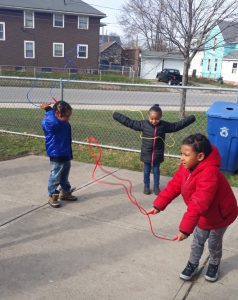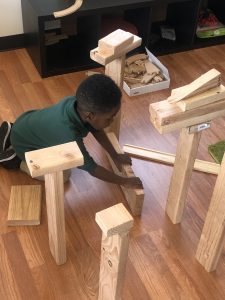No matter where learning takes place – in the classroom, at home, virtually or on-the-go – it’s important to check-in physically and emotionally to ensure children are feeling energized, supported and ready for what’s ahead. Modify these tips and resources in a way that supports you and your setting best and get creative!
Click here for a list of tools and resources for on-line learning.

Check in physically.
While children may not be moving from one classroom to the next or to and from lunch and recess, a virtual or at home learning environment can still have many of the supports that a typical classroom or school has. Check in with how children are feeling physically throughout the day and pay attention to sedentary patterns. Make sure they are fueling their bodies with good foods and are balancing their day with physical activity and play.
- Break up the day with active brain breaks to recharge the body and brain. Get the wiggles out together with an online video or throw on some music and just allow your bodies to move. You can also integrate movement into lessons for active learning opportunities – squats for math, spelling with yoga, etc.
- Pay attention to children’s posture throughout the day. When you notice slouching, especially when sitting on the floor, encourage children to get some height under their seat. You can do this with folded blankets, a pillow or fitness blocks. Doing so helps to lengthen the spine which can alleviate lower back pain and support healthier posture. Stretching and moving helps children to reset and realign!
- Schedule “recess” in your day-to-day routine. Take a nature walk for fresh air or kick around a soccer ball and develop new skills. Use this time to break up the day and create a space for more unstructured play. Start a pots and pans band, build a fort with sheets or use a pillow cushion raft to head off on a new adventure.
Make sure children are staying on a routine and carve out time for meals and snacks. Use this time to discuss the mind-body connection and get children thinking about the power of food and how it fuels our bodies for the activities we love most. Spend some time exploring food even further by getting kids in the kitchen and cooking together.
-
Stay Connected - Digital Tips
- Create a virtual challenge to encourage children to practice goal setting individually and alongside their peers. How many minutes of movement? Daily stretching or yoga? 8 glasses of water or rethinking their drink?
- Use free video conferencing platforms to create space for brain breaks, recess or a 5-minute dance party – any kind of movement with friends! If video conferencing is not available, have families share photos via email and use free online platforms to create a digital album or slideshow.
- Encourage children and families to stay connected with virtual lunch or snack time. Teachers and school staff – join in with video conferencing and use this time to play get to know you games or to simply check-in.
-
Physical Activity and Movement Resources
- Active Learning Opportunities (AFHK)
- Brain Breaks and Energizers (AFHK)
- Go Noodle Video Library (Go Noodle)
- Recess at Home (AFHK)
- CATCH At Home: Physical Activity and Health (CATCH)
- Playworks Game Library (Playworks)
- Playworks At Home Digital and Printable Resources (Playworks)
- Tools for Creating an Active Home (OPEN)
- Free Resources for Staying Active at Home (Active Schools)
- Nutrition Resources
Check in emotionally.
 Children experience many of the same feelings and emotions that adults do but may not fully understand why or how to communicate about them. Knowing how to recognize, process and react to different feelings is all a part of social emotional learning – a process that continues throughout our lifetime. Integrate opportunities for emotional check-ins and supports for emotional regulation and self-management.
Children experience many of the same feelings and emotions that adults do but may not fully understand why or how to communicate about them. Knowing how to recognize, process and react to different feelings is all a part of social emotional learning – a process that continues throughout our lifetime. Integrate opportunities for emotional check-ins and supports for emotional regulation and self-management.
- Discover ways to make the most of screen time – whether it be for learning, connection, mindfulness, movement or simply for play. Be mindful of screen brightness and device volume when using headphones, and balance on-screen activities with off-screen activities. Pairing online learning with hands on activities is a great way to create space for children to develop skills in self-awareness and self-management while learning something new.
- While physical activity breaks play a huge role in creating healthier learning environments, it doesn’t always have to be so literal. Activity generated during unstructured play time—or play time during lessons—is equally beneficial to students, especially for creativity, focus, and behavior. Create spaces for children to practice mindfulness, create or reflect to better manage impulses and navigate feelings as they come up.
- Invite children to engage in conversations around their feelings – with you, their peers or with themselves. Create an environment where children feel encouraged to share as much or as little as they are ready. Integrate these conversations into activities they enjoy the most – when they feel the most at ease or empowered. Dedicating space to openly talk through feelings, ask questions and problem solve supports children in developing self-management skills and builds resiliency.
-
Stay Connected - Digital Tips
- Use free video conferencing platforms to check-in with children and create a space for open conversation. Develop social awareness while discussing current events and acknowledge ways to navigate feelings and emotions that may arise or use prompts to explore empathy.
- Set up opportunities for group work or partner work via video conferencing or collaboration apps.
- Check in with those you know who may be struggling to give them an outlet and a source of social connection with a loving adult or peer. Use chat or messaging features to set up a “Virtual Buddy Bench” and create space where children can reach out if they need to talk.
- Mindful spaces go beyond the physical environment. Start lessons with a mindful moment or short breathing exercise to set intentions and re-center. Pull together resources that children can utilize when feeling overwhelmed or needing a break – meditation videos, doodling, e-painting apps, or virtual calm down jars.
-
Mindfulness and Play Resources
- Mindfulness: Journaling, Breathing and More (AFHK)
- Mindfulness and Yoga Programs and Videos (Alo Gives)
- Wellness and Social Emotional Learning Resources (Breathe for Change)
- Self-Care for Educators, Families and Children (Breathe for Change)
- Mindful Remote Learning (Yoga Foster)
- Yoga for Children (AFHK)
- Yoga Ed Video Library (Yoga Ed)
- Making Time to Play (AFHK)
- Easy, On the Go Play Activities (AFHK)
- Sensory Play (AFHK)
- Distance Learning Yoga Sequence (Michelle Auld: Brooklyn Center Community Schools)
- Creative Spaces to Inspire
Original source: https://www.actionforhealthykids.org/staying-healthy-and-active-with-virtual-and-at-home-learning/